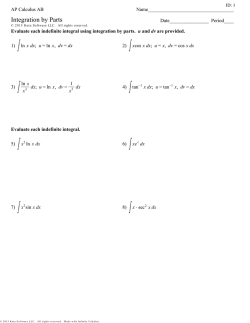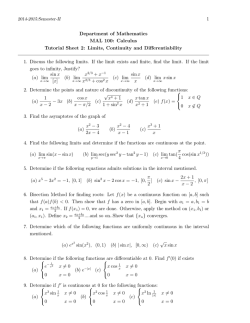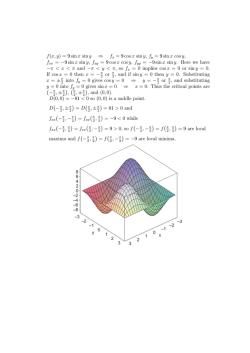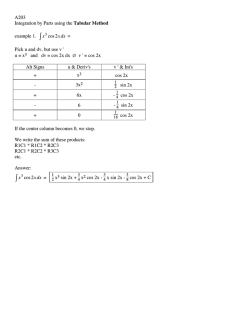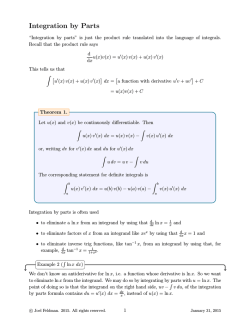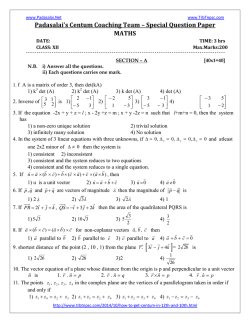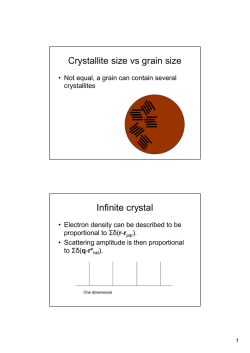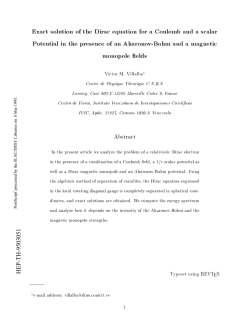
MathCity.org - WordPress.com
Exercise 2.5 (Solutions) MathCity.org Calculus and Analytic Geometry, MATHEMATICS 12 Merging man and maths Available online @ http://www.mathcity.org, Version: 2.1.5 Some Important Derivative Formulas d • c=0 where c is constant dx d d • tan x = sec2 x • dx sin x = cos x dx d • d cos x = − sin x • cot x = − csc2 x dx dx 1 d −1 d 1 • Tan −1x = • dx Sin x = 2 1− x dx 1+ x2 d −1 • d Cos −1 x = −1 • Cot −1 x = 2 dx dx 1 + x2 1− x • d n x = nx n −1 dx d • csc x = − csc x cot x dx d • sec x = sec x tan x dx d 1 Sec −1 x = dx x x2 −1 d −1 • Csc −1 x = dx x x2 −1 • Question # 1(i) Suppose y = sin 2 x ⇒ y + δ y = sin 2( x + δ x) ⇒ δ y = sin 2( x + δ x) − y = sin 2( x + δ x) − sin 2x Dividing both sides by δ x δ y sin(2 x + 2δ x) − sin 2 x = δx δx 2 x + 2δ x + 2 x 2 x + 2δ x − 2 x 2cos sin 2 2 = δx 2cos ( 2 x + δ x ) sin (δ x ) = δx Taking limit as δ x → 0 2cos ( 2 x + δ x ) sin (δ x ) δy lim = lim δ x →0 δ x δ x →0 δx sin (δ x ) dy = 2 δlim cos 2 x + δ x ⋅ ( ) x →0 dx δx sin (δ x ) = 2 δlim cos 2 x + δ x ⋅ lim ( ) x →0 δ x →0 δx sin θ = 2 cos ( 2 x + 0 ) ⋅ (1) ∵ lim =1 θ →0 ⇒ dy = 2cos 2 x dx θ FSc-II / Ex- 2.5 - 2 Question # 1(ii) y = tan3x Let ⇒ y + δ y = tan 3 ( x + δ x ) ⇒ δ y = tan ( 3x + 3δ x ) − tan 3x = sin ( 3x + 3δ x ) sin 3x − cos ( 3 x + 3δ x ) cos3 x = sin ( 3 x + 3δ x ) cos3x − cos ( 3 x + 3δ x ) sin 3 x cos ( 3x + 3δ x ) cos3 x sin ( 3x + 3δ x − 3x ) sin ( 3δ x ) = cos ( 3x + 3δ x ) cos3x cos ( 3x + 3δ x ) cos3x Dividing by δ x sin ( 3δ x ) δy 1 = ⋅ δx δ x cos ( 3x + 3δ x ) cos3x Taking limit as δ x → 0 sin ( 3δ x ) δy lim = lim δ x →0 δ x δ x →0 δ x cos ( 3 x + 3δ x ) cos3 x = sin ( 3δ x ) dy 1 3 = lim ⋅ ⋅ δ x →0 dx cos ( 3x + 3δ x ) cos3x 3 δx × ing and ÷ ing 3 on R.H.S sin ( 3δ x ) 1 ⋅ lim δ x →0 δ x→0 cos ( 3 x + 3δ x ) cos3 x 3δ x 1 = 3(1) ⋅ cos ( 3 x + 3(0) ) cos3 x 3 3 = = cos 2 3x cos3 x cos3 x = 3 lim ⇒ dy = 3sec2 3x dx Question # 1(iii) y = sin 2 x + cos 2 x Let ⇒ y + δ y = sin 2 ( x + δ x ) + cos 2 ( x + δ x ) ⇒ δ y = sin 2 ( x + δ x ) + cos 2 ( x + δ x ) − y = sin 2 ( x + δ x ) + cos 2 ( x + δ x ) − sin 2 x − cos 2 x = sin ( 2 x + 2δ x ) − sin 2 x + cos ( 2 x + 2δ x ) − cos 2 x 2 x + 2δ x + 2 x 2 x + 2δ x − 2 x = 2cos sin 2 2 2 x + 2δ x − 2 x 2 x + 2δ x − 2 x + −2sin sin 2 2 FSc-II / Ex- 2.5 - 3 = 2cos ( 2 x + δ x ) sin (δ x ) − 2sin ( 2 x + δ x ) sin (δ x ) Dividing by δ x δy 1 = 2cos ( 2 x + δ x ) sin (δ x ) − 2sin ( 2 x + δ x ) sin (δ x ) δx δx Taking limit as δ x → 0 δy 1 lim = lim 2cos ( 2 x + δ x ) sin (δ x ) − 2sin ( 2 x + δ x ) sin (δ x ) δ x →0 δ x δ x →0 δ x sin (δ x ) sin (δ x ) dy = 2 lim cos ( 2 x + δ x ) lim − 2 lim sin ( 2 x + δ x ) lim δ x →0 δ x →0 δ x →0 δ x →0 dx δx δx sin θ = 2cos ( 2 x + 0 ) ⋅ (1) − 2sin ( 2 x + 0 ) ⋅ (1) Since lim =1 θ →0 θ dy ⇒ = 2cos 2 x − 2sin 2 x dx Question # 1(iv) Let y = cos x 2 ⇒ y + δ y = cos( x + δ x) 2 ⇒ δ y = cos( x + δ y ) 2 − cos x 2 ( x + δ x)2 + x 2 ( x + δ x)2 − x2 = − 2sin sin 2 2 x 2 + 2 xδ x + δ x 2 + x 2 x 2 + 2 xδ x + δ x 2 − x 2 = − 2sin sin 2 2 2 x 2 + 2 xδ x + δ x 2 2 xδ x + δ x 2 = − 2sin ⋅ sin 2 2 δ x2 δx = − 2sin x 2 + xδ x + ⋅ sin x + δ x 2 2 Dividing by δ x δy 1 δ x2 δx = − ⋅ 2sin x 2 + xδ x + ⋅ sin x + δ x δx δx 2 2 δx × ing and ÷ ing x + on R.H.S 2 δx x+ 2 2 δy 2 δx δx 2 ⇒ = − sin x + xδ x + ⋅ sin x + δ x ⋅ 2 2 δx δ x x + δ x 2 FSc-II / Ex- 2.5 - 4 δx sin x + 2 δ x 2 δx δx 2 = − 2sin x + xδ x + ⋅ x + ⋅ δx 2 2 x + x δ 2 Taking limit as δ x → 0 δx sin x + 2 δ x 2 δy δx δx 2 lim = − lim 2sin x + xδ x + ⋅ ⋅ x + δ x →0 δ x δ x →0 δx 2 2 x x + δ 2 δx sin x + 2 δ x 2 dy δx δx 2 ⇒ = − 2 lim sin x + xδ x + ⋅ lim ⋅ lim x + δ x→0 δ x→0 δx dx 2 δ x →0 2 δ x x + 2 = − 2sin x 2 + (0) + (0) ⋅ (1) ⋅ ( x + (0) ) ( ⇒ ) dy = − 2 x sin x 2 dx Question # 1(v) Let y = tan 2 x ⇒ y + δ y = tan 2 ( x + δ x ) ⇒ δ y = tan 2 ( x + δ x ) − tan 2 x = ( tan ( x + δ x ) + tan x ) ⋅ ( tan ( x + δ x ) − tan x ) = sin x + δ x sin x ( tan ( x + δ x ) + tan x ) ⋅ cos( x + δ x) − cos x ( ) sin ( x + δ x ) cos x − sin x cos ( x + δ x ) = ( tan ( x + δ x ) + tan x ) ⋅ cos ( x + δ x ) cos x sin ( x + δ x − x ) = ( tan ( x + δ x ) + tan x ) ⋅ cos ( x + δ x ) cos x sin δ x = ( tan ( x + δ x ) + tan x ) ⋅ cos x + x cos x δ ( ) Dividing by δ x δy 1 sin δ x = tan ( x + δ x ) + tan x ) ⋅ ( δx δx cos ( x + δ x ) cos x Taking limit when δ x → 0 δy 1 sin δ x lim = lim tan ( x + δ x ) + tan x ) ⋅ ( δ x →0 δ x δ x →0 δ x cos ( x + δ x ) cos x FSc-II / Ex- 2.5 - 5 ⇒ ⇒ tan ( x + δ x ) + tan x dy sin δ x = lim ⋅ lim δ x→0 δ x →0 δ x dx cos ( x + δ x ) cos x tan ( x + 0 ) + tan x 2 tan x tan x + tan x = = ⋅ (1) = cos 2 x cos x ⋅ cos x cos ( x + 0 ) cos x dy = 2 tan x sec2 x dx Question # 1 (vi) Let y = tan x ⇒ y +δ y = ⇒ δy = = = = tan ( x + δ x ) tan ( x + δ x ) − tan x ( tan ( x + δ x ) + tan x tan ( x + δ x ) − tan x ⋅ tan ( x + δ x ) + tan x tan ( x + δ x ) − tan x ) tan ( x + δ x ) + tan x sin ( x + δ x ) sin x ⋅ − tan ( x + δ x ) + tan x cos ( x + δ x ) cos x Now do yourself as above. 1 Question # 1 (vii) Let y = cos x ⇒ y + δ y = cos x + δ x ⇒ δ y = cos x + δ x − cos x x +δ x + x x +δ x − x = − 2sin sin 2 2 Dividing by δ x x +δx + x x +δ x − x 2sin sin 2 2 δy = − δx δx Taking limit as δ x → 0 x +δ x + x x +δ x − x sin sin 2 2 δy lim = − 2 lim δ x →0 δ x δ x →0 δx As δ x = ( x + δ x + x )( x + δ x − x ) , putting in above FSc-II / Ex- 2.5 - 6 x +δ x + x x +δx − x sin sin 2 2 dy ⇒ = − 2 lim δ x →0 dx ( x + δ x + x )( x + δ x − x ) x +δx + x x +δx − x sin sin 2 2 = − lim ⋅ lim δ x →0 ( x + δ x + x ) δ x →0 x + δ x − x 2 x+0 + x sin sin x 2 dy = − ⋅ (1) ⇒ = − dx ( x +0 + x) 2 x ( ) Question # 2(i) Assume y = x 2 sec 4 x Differentiating w.r.t x dy d 2 = x sec 4 x dx dx d d = x 2 sec 4 x + sec 4 x x 2 dx dx d = x 2 sec 4 x tan 4 x (4 x) + sec 4 x (2 x) dx 2 = x sec 4 x tan 4 x(4) + 2 x sec 4 x = 2 x sec 4 x ( 2 x tan 4 x + 1) Question # 2(ii) Let y = tan 3 θ sec 2 θ Diff. w.r.t θ dy d = tan 3 θ sec 2 θ dθ dθ d d = tan 3 θ sec2 θ + sec2 θ tan 3 θ dθ dθ d d = tan 3 θ 2secθ secθ + sec 2 θ 3tan 2 θ tan θ dθ dθ = tan 3 θ ( 2secθ ⋅ secθ tan θ ) + sec 2 θ 3tan 2 θ ⋅ sec 2 θ ( ( = sec 2 θ tan 2 θ 2 tan 2 θ + 3sec 2 θ Question # 2(iii) 2 Let y = ( sin 2θ − cos3θ ) Diff. w.r.t θ ) ) FSc-II / Ex- 2.5 - 7 dy d 2 = ( sin 2θ − cos3θ ) dθ dθ d = 2 ( sin 2θ − cos3θ ) ( sin 2θ − cos3θ ) dθ d d = 2 ( sin 2θ − cos3θ ) cos 2θ ⋅ (2θ ) + sin 3θ ⋅ (3θ ) dθ dθ = 2 ( sin 2θ − cos3θ )( cos 2θ ⋅ (2) + sin 3θ ⋅ (3) ) = 2 ( sin 2θ − cos3θ )( 2cos 2θ + 3sin 3θ ) Question # 2(iv) y = cos x + sin x Let 1 1 = cos( x ) 2 + ( sin x ) 2 Diff. w.r.t x 1 1 dy d = cos( x) 2 + ( sin x ) 2 dx dx 1 d 1 1 −1 d = − sin( x) 2 x 2 + ( sin x ) 2 ( sin x ) dx 2 dx 1 1 −1 −1 1 = − sin( x ) 2 x 2 + ( sin x ) 2 ( cos x ) 2 2 1 cos x sin x = − 2 sin x x Question # 3(i) Since y = x cos y dy d = x cos y dx dx d dx = x cos y + cos y dx dx dy = x (− sin y ) + cos y (1) dx dy dy ⇒ + x sin y = cos y ⇒ dx dx dy cos y ⇒ = dx 1 + x sin y Question # 3(ii) Since x = y sin y dx d = ( y sin y ) dx dx ( 1 + x sin y ) dy = cos y dx FSc-II / Ex- 2.5 - 8 d dy sin y + sin y dx dx dy dy dy = y cos y + sin y = ( y cos y + sin y ) dx dx dx dy 1 ⇒ = dx y cos y + sin y ⇒ 1 = y Question # 4(i) Since y = cos 1+ x 1 + 2x Diff. w.r.t x dy d 1+ x = cos dx dx 1 + 2x 1 1+ x d 1+ x 1 + x d 1 + x 2 = − sin = − sin 1 + 2 x dx 1 + 2 x 1 + 2 x dx 1 + 2 x 1+ x 1 1+ x = − sin ⋅ 1 + 2x 2 1 + 2x −1 d 1+ x dx 1 + 2 x 1 1 + 2x d 1 + x − 1 + x d 1 + 2x ) ( ) ( ) ( ) 1 + x 1 1 + 2x 2 ( dx dx = − sin ⋅ 2 1 + 2x 2 1 + x (1 + 2 x ) 2 1 1 + x (1 + 2 x ) 2 (1 + 2 x )(1) − (1 + x )( 2 ) = − sin ⋅ 2 1 + 2 x 2 (1 + x ) 12 (1 + 2 x ) 1 1 + x (1 + 2 x ) 2 1 + 2 x − 2 − 2 x = − sin ⋅ 1 + 2 x 2 (1 + x ) 12 (1 + 2 x )2 1 1 + x (1 + 2 x ) 2 −1 = − sin ⋅ 1 + 2 x 2 (1 + x ) 12 (1 + 2 x )2 1 1 1+ x (1 + 2 x ) 2 = sin ⋅ 2 1 + 2 x 2 (1 + x ) 12 (1 + 2 x ) 2− 12 ⇒ dy 1 1+ x = 3 sin dx 1 + 2x 2 1 + x (1 + 2 x ) 2 Question # 4(ii) Do yourself as above. FSc-II / Ex- 2.5 - 9 Question # 5(i) Let y = sin x and u = cot x Diff. y w.r.t x dy d = sin x dx dx = cos x Now diff. u w.r.t x du d = cot x dx dx = − csc2 x dx 1 ⇒ = − du csc 2 x = − sin 2 x Now by chain rule dy dy dx = ⋅ du dx du = ( cos x ) − sin 2 x = − sin 2 x cos x ( ) Question # 5(ii) Let y = sin 2 x and u = cos 4 x Diff. y w.r.t x dy d = sin 2 x dx dx d = 2sin x ( sin x ) = 2sin x cos x dx Now diff. u w.r.t x du d = cos 4 x dx dx d = 4cos3 x ( cos x ) = 4cos3 x ( − sin x ) dx = − 4sin x cos3 x dx 1 ⇒ = − du 4sin x cos3 x Now by chain rule dy dy dx = ⋅ du dx du 1 = ( 2sin x cos x ) − 3 4sin x cos x FSc-II / Ex- 2.5 - 10 1 = − sec 2 x 2 Question # 6 Since tan y (1 + tan x ) = 1 − tan x 1 − tan x ⇒ tan y = 1 + tan x tan π4 − tan x 1 − tan x = = 1 + 1 ⋅ tan x 1 + tan π4 ⋅ tan x π = tan − x 4 ⇒ y = π 4 −x Diff. w.r.t x dy d π = − x dx dx 4 ⇒ = 0 −1 dy = −1 dx Question # 7 Since y = tan x + tan x + tan x + ...∞ Taking square on both sides y 2 = tan x + tan x + tan x + ...∞ = tan x + tan x + tan x + tan x + ...∞ ⇒ y = tan x + y Diff. w.r.t x d 2 d y = ( tan x + y ) dx dx dy dy dy dy ⇒ 2y = sec 2 x + ⇒ 2y − = sec 2 x dx dx dx dx dy ⇒ ( 2 y − 1) = sec2 x dx 2 Question # 8 x = a cos3 θ , y = b sin 3 θ Diff. x w.r.t θ dx d = a cos3 θ dθ dθ ( ) FSc-II / Ex- 2.5 - 11 d ( cosθ ) = 3a cos2 θ ( − sin θ ) dθ dx dθ −1 ⇒ = − 3a sin θ cos 2 θ ⇒ = dθ dx 3a sin θ cos 2 θ Now diff. y w.r.t θ dy d = b sin 3 θ dθ dθ d = b ⋅ 3sin 2 θ ( sin θ ) = 3b sin 2 θ cosθ dθ Now by chain rule dy dy dθ = ⋅ dx dθ dx 1 = 3b sin 2 θ cosθ ⋅ − 3a sin θ cos 2 θ b = − tan θ a dy dy ⇒ a = − b tan θ ⇒ a + b tan θ = 0 dx dx = a ⋅ 3cos 2 θ ( ) Question # 9 x = a ( cos t + sin t ) and y = a ( sin t − t cos t ) Do yourself Derivative of inverse trigonometric formulas (i) 1 d Sin −1 x = dx 1 − x2 See proof on book page 76 (ii) d −1 Cos −1 x = dx 1 − x2 Proof Let y = cos −1 x where x ∈ [ 0, π ] ⇒ cos y = x Diff. w.r.t x d dx dy cos y = ⇒ − sin y = 1 dx dx dx dy 1 =− dx sin y −1 = Since sin y is positive for x ∈ [ 0, π ] 1 − cos 2 y −1 = 1 − x2 FSc-II / Ex- 2.5 - 12 (iii) d 1 Tan−1x = dx 1+ x2 See proof on book at page 77 (iv) d −1 Cot −1 x = dx 1+ x2 Proof Let y = cot −1 x ⇒ cot y = x Diff. w.r.t x d d dy cot y = x ⇒ − csc2 y = 1 dx dx dx dy −1 ⇒ = dx csc 2 y −1 = ∵ 1 + cot 2 y = csc 2 y 2 1 + cot y dy 1 ⇒ = − dx 1 + x2 d 1 Sec −1 x = dx x x2 − 1 Proof ⇒ sec y = x Let y = sec −1 x Diff. w.r.t x d d dy sec y = x ⇒ sec y tan y = 1 dx dx dx dy 1 ⇒ = dx sec y tan y 1 = ∵ 1 + tan 2 y = sec 2 y 2 sec y sec y − 1 d 1 ∵ sec y = x ⇒ Sec −1 x = dx x x2 − 1 (v) (vi) d 1 Csc −1 x = − dx x x2 − 1 See on book at page 77 Question # 10(i) x Let y = Cos −1 a Diff. w.r.t x FSc-II / Ex- 2.5 - 13 dy d x = Cos −1 dx dx a −1 1 d −1 d x = ⋅ x = 2 2 dx a a dx x x 1− 2 1− a a −1 1 −a 1 −1 = ⋅ (1) = ⋅ = a2 − x2 a a2 − x2 a a2 − x2 a2 Ans Question # 10(ii) x Let y = cot −1 a Diff w.r.t x dy d x = cot −1 dx dx a −1 d x −1 1 d = ⋅ = 2 ⋅ ( x) 2 2 a + x dx a a dx x 1+ a2 a −a 2 1 −a = 2 ⋅ (1) = 2 . 2 a +x a a + x2 Question # 10(iii) 1 a Let y = Sin −1 a x Diff. w.r.t x dy 1 d a = Sin −1 dx a dx x 1 1 d −1 1 1 d a = ⋅a x = 2 2 2 dx x a dx a x −a a 1− x2 x x x 1 1 − 2 = − Ans = − x −2 = 2 2 2 2 2 2 x x −a x −a x x −a ( ) ( ) Question # 10(iv) Let y = Sin −1 1 − x 2 Diff. w.r.t x dy d = Sin −1 1 − x 2 dx dx FSc-II / Ex- 2.5 - 14 1 = ( 1− 1 = x2 ⋅ 1− x 2 ) 1 1 2 1 − x2 ( ⋅ 2 ) 1 2 1 d 1 − x2 = dx ( −2 x ) = − 1 − 1 + x2 1 x ⋅ x 1 − x2 ⋅ 1 1 − x2 2 ( = − ) −1 d 1 − x2 dx ( 2 ) 1 1 − x2 Question # 10(v) x2 + 1 Let y = Sec −1 2 x −1 Diff. w.r.t x x2 + 1 dy d = Sec −1 2 dx dx x −1 1 = 2 x2 + 1 x2 + 1 2 2 −1 x −1 x −1 d x2 + 1 ⋅ 2 dx x − 1 = x +1 2 x −1 2 ( d 2 d 2 2 2 x − 1 dx x + 1 − x + 1 dx x − 1 ⋅ 2 x2 − 1 ( 1 2 ) ( ) x2 + 1 − x2 − 1 2 ( x − 1) 2 2 ) ( ( x2 + 1 2 ⋅ − 1 x ( ( ) ( ) ) ( ( ) ( 2 ) −1 2 ( ( ) ) Question # 10(vi) Do yourself as above. Question # 10(vii) Do yourself as above. Question # 11 y x = Tan−1 Since x y ) ( ) ⇒ y = x Tan −1 x y ) ) 2 x x2 − 1 − x2 − 1 = ⋅ 2 2 4 2 4 2 2 x + 1 ⋅ x + 2x + 1 − x + 2x − 1 x − 1 − 4x −2 1 = = ⋅ ( 2 x ( −2 ) ) = 2 2 x + 1 ⋅ 2x x +1 x2 + 1 ⋅ 4 x2 (x ( ) ( x2 − 1 ( 2 x ) − x2 + 1 ( 2 x ) ⋅ 2 2 4 2 4 2 x −1 x + 2x + 1 − x + 2x + 1 ( x 2 − 1) 1 = ) ( ) ( ) Ans ) FSc-II / Ex- 2.5 - 15 Diff. w.r.t x dy d −1 = x Tan dx dx x y d d 1 d x −1 x −1 x −1 x = x Tan ⋅ ( x) = x + Tan ⋅ (1) + Tan 2 dx y y dx y y dx x 1+ y dy 1 y (1) − x x dy y dx + Tan −1 x = =x 2 y−x + 2 2 2 2 y +x dx x y y y +x y2 dy xy x2 dy y ⇒ = 2 − 2 ⋅ + 2 2 dx y +x y + x dx x dy x2 dy xy y ⇒ + 2 ⋅ = 2 + 2 2 dx y + x dx y +x x dy y Proved ⇒ = dx x Question # 12 Since y = tan pTan −1 x ( ) ⇒ Tan −1 y = pTan −1 x Differentiating w.r.t x d d Tan −1 y = p Tan −1 x dx dx 1 dy 1 ⇒ = p⋅ ⇒ 2 1 + y dx 1 + x2 ⇒ x 2 dy y x2 ⇒ 1 + 2 ⋅ = + 1 y + x 2 dx x y 2 + x2 dy (1 + x ) dx 2 (1 + x ) y − p (1 + y ) = 0 2 2 1 ( = p 1 + y2 Since ) dy = y1 dx Error Analyst Muzammil Ahsan 2009-11 Govt. Post Graduate Collage Jauharabad Distt. Khushab Nain Malik 2012-14 Muhammad Usman Saleem (2013-15) DPS & IC Jauharabad Distt. Khushab Book: Exercise 2.5 Calculus and Analytic Geometry Mathematic 12 Punjab Textbook Board, Lahore. Edition: May 2013. Made by: Atiq ur Rehman ([email protected]) Available online at http://www.MathCity.org in PDF Format (Picture format to view online). Page Setup used: A4. Printed: September 25, 2014.
© Copyright 2025
